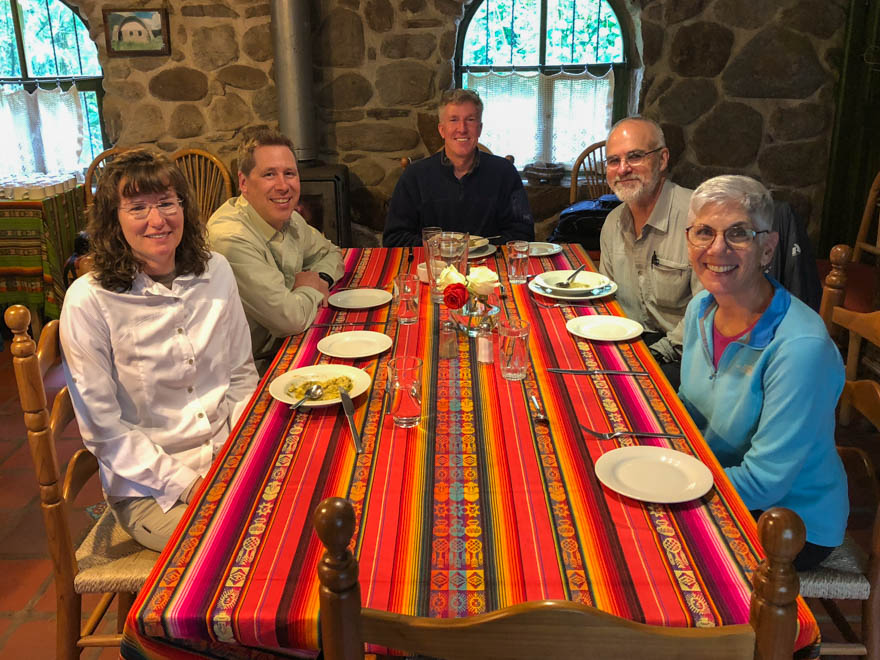Day 1 – Saturday
We all meet for dinner at a small birding lodge near the Quito Airport. We have Patrick and Cheryl from Colorado and Bob and Dee from North Carolina joining us for a week of hummingbird photography.
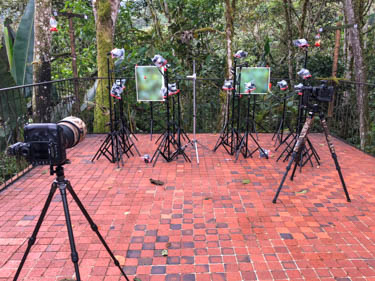
We setup the multi-flash system to achieve tack sharp images of these amazing birds
Time to get some rest, as the hummingbird photography starts tomorrow.
Day 2 – Sunday
After meeting for a nice breakfast, we headed out with our driver for a two-hour drive through the Ecuadorian mountains as we journey from 9200 feet (2800 meters) elevation down to 5740 feet (1750 meters). During the drive we see will two ecosystems collide where vegetation grows up from the steep mountains and the rainforest begins. We arrive in the heart of the Cloud Forest and get setup immediately to photograph the hummingbirds. Today the rain is in and out, so we keep working the hummingbirds in our light setup when it’s not raining and focus on natural light images from the shelter when the light rain begins.
During our stay we photographed the following species of hummingbirds:
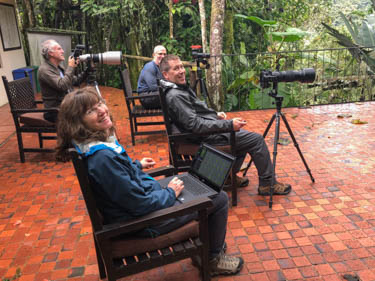
Now this is comfortable wildlife photography !
- Violet-tailed Sylph (Aglaiocercus coelestis)
- Booted Racket-tail (Ocreatus underwoodii)
- Purple-bibbed Whitetip (Urosticte benjamini)
- Fawn-breasted Brilliant (Heliodoxa rubinoides)
- Brown Violetear (Colibri delphinae)
- Green Violetear (Colibri thalassinus)
- Brown Inca (Coeligena wilsoni)
- Purple-throated Woodstar (Callipholox mitchellii)
- Rufous-tailed Hummingbird (Amazilia tzacatl)
- Buff-tailed Coronet (Boissonneaua flavescens)
- Sparkling Violetear (Colibri coruscans)
- White-necked Jacobin (Florisuga mellivora)
- Andean Emerald (Amazilia franciae)
- Green-crowned Brilliant (Heliodoxa jacula)
Dee and Bob headed out for a hike on the many trails in the area as they prepare for their exciting four-day Machu Pichu trek next week in Peru.
As the evening came, we packed up the gear, and downloaded to review all our images and make any adjustments for tomorrow. Many excellent images were captured today including action shots of Booted Racket-tails fighting and the beautiful Violet-tailed Sylph displaying its colors in the multi-flash system.
Day 3 – Monday and Day 4 – Tuesday
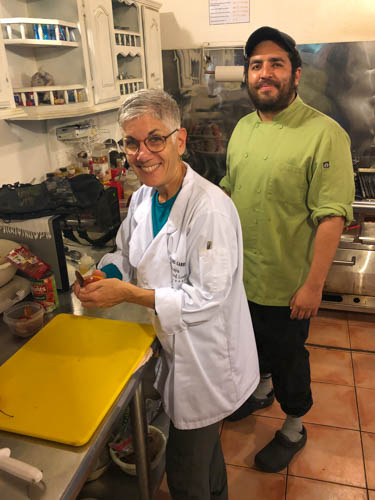
During the trip, Dee is learning to cook many of the yummy local dishes from Luis, the lodges chef.
Some of the other birds we photographed while at this location:
- Golden-headed quetzal
- Masked Trogon
- Crimson-rumped toucanet
- Oropendola
- Rufous Motmot
- Red-headed barbet
- Toucan barbet
- Squirrel Cuckoo
- Orange-crowned Euphonia
- Golden-hooded tanager
- Black-capped tanager
- Beryl-spangled tanager
- Golden-naped tanager
- Blue-winged mountain tanager
Day 5 – Wednesday
In the morning, we packed up and departed the lodge and began our journey to the amazon region to photograph many of the different species that reside at a higher altitude.
On our way, we stopped and spent the morning photographing at another hummingbird lodge to photograph a few new species of hummingbirds that we have not seen yet.
Some of the species of hummingbirds we photographed:
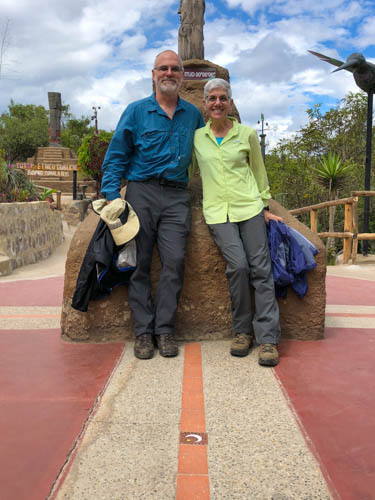
Bob and Dee in separate hemispheres ! Having a little fun on the equator.
- White-necked Jacobin (Florisuga mellivora)
- Green-crowned Brilliant (Heliodoxa jacula)
- Brown Violetear (Colibri delphinae)
- Green Violetear (Colibri thalassinus)
- Sparkling Violetear (Colibri coruscans)
- Brown Inca (Coeligena wilsoni)
- Buff-tailed Coronet (Boissonneaua flavescens) Purple-bibbed Whitetip (Urosticte benjamini)
- Fawn-brested Brilliant) (Heliodoxa rubinoides)
- Purple-throated Woodstar (Callipholox mitchellii)
- Western Emerald (Chorostilbon melanorhynchus)
- Rufous-tailed Hummingbird (Amazilia tzacatl)
- Andean Emerald (Amazilia franciae)
- Green-crowned woodnymph (Thalurania colombica fannyi)
Some of the birds we photographed:
- Red-headed barbet
- White-lined tanager
- Orange-crowned euphonia
- Tricolored brush finch
- Blue-gray tanager
- Golden tanager
- Silver-throated tanager
After lunch, we continue our journey and take some time to learn about Ecuador’s history and take photos on the equator (Latitude 00’ 00”)
We learned about the amazon, remote tribes, and played many games on the equator. Cheryl even reached the impressive rank of “Egg Master” as she was able to balance an egg on a nail on the equator. We then learned how dark chocolate is made, and sampled many different kinds. With diploma in hand, we continued our trek to our highest point, Papallacta Pass, over 13,000 feet (4,000 meters). Once we crossed the mountain pass, we descended into the valley and arrive at our next hummingbird lodge. As we arrived, we enjoy some refreshments and relaxed for the evening by the fire.
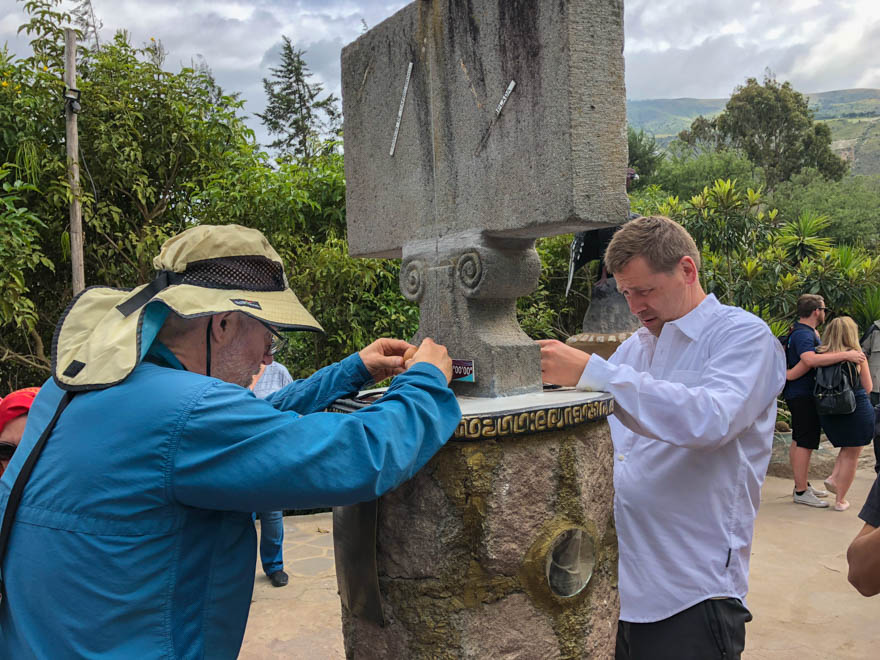
On our way over to our final lodge, we visited the equator. The gentlemen are very focused trying to balance an egg on a nail (Cheryl achived the impressive diploma for Eggmaster !)
Day 6 – Thursday and Day 7 – Friday
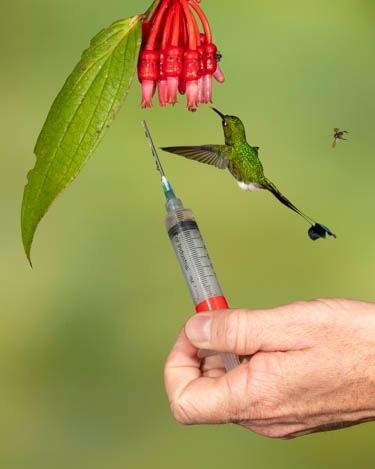
Matt adding a little more necter to the flower as a Booted Racket-tail hummingbird can’t wait to drink from it.
While not photographing the hummingbirds, we enjoyed the excellent Ecuadorian cuisine.
Here are some the hummingbirds that we photographed:
- Sword-billed Hummingbird (Ensifera ensifera)
- Chestnut-Breasted Coronet (Boissonneaua matthewsii)
- Speckled Hummingbird (Adelomyia melanogenys)
- Long-tailed Sylph (Aglaiocercus kingii)
- White-bellied Woodstar (Chaetocercus mulsant)
- Collared Inca (Coeligena torquata)
- Buff-tailed Coronet (Boissonneaua flavescens)
- Tourmaline Sunangel (Heliangelus exortis)
In the evening we would relax by the fire and the discussed photo post-processing techniques.
Day 8 – Saturday (Sword-bill Saturday)
Our last day, we continued photographing the hummingbirds. As everyone had so many excellent shots in the multi-flash of the new species of hummingbirds, everyone turned their attention to getting a couple more shots of the Sword-billed hummingbirds. As the day went on, we packed up our gear and departed out last lodge of the trip. We headed to the airport and said our goodbyes.
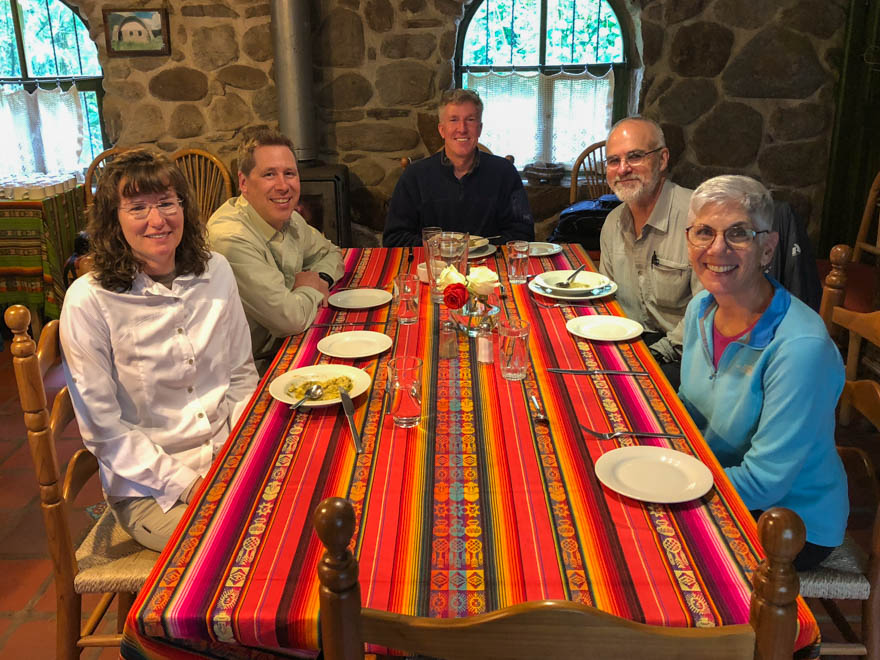
Enjoying the fantastic food of Ecuador at our high altitude lodge.

